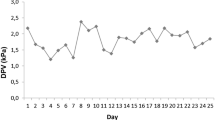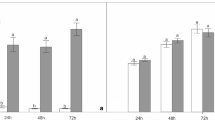Abstract
The effects of aluminium (Al) ions on the metabolism of root apical meristems were examined in 4-day-old seedlings of two cereals which differed in their tolerance to Al: wheat cv. Grana (Al-sensitive) and rye cv. Dańkowskie Nowe (Al tolerant). During a 24 h incubation period in nutrient solutions containing 0.15 mM and 1.0 mM of Al for wheat and rye, respectively, the activity of first two enzymes in the pentose phosphate pathway (G-6-PDH and 6-PGDH) decreased in the sensitive cultivar. In the tolerant cultivar activities of these enzymes increased initially, then decreased slightly, and were at control levels after 24 h. In the Al-sensitive wheat cultivar a 50% reduction in the activity of 6-phosphogluconate dehydrogenase was observed in the presence of Al. Changes in enzyme activity were accompanied by changes in levels of G-6-P- the initial substrate in the pentose phosphate pathway. When wheat was exposed for 16 h to a nutrient solution containing aluminium, a 90% reduction in G-6-P concentration was observed. In the Al-tolerant rye cultivar, an increase and subsequently a slight decrease in G-6-P concentration was detected, and after 16 h of Al-stress the concentration of this substrate was still higher than in control plants. This dramatic Al-induced decrease in G-6-P concentration in the Al-sensitive wheat cultivar was associated with a decrease in both the concentration of glucose in the root tips as well as the activity of hexokinase, an enzyme which is responsible for phosphorylation of glucose to G-6-P. However, in the Al-tolerant rye cultivar, the activity of this enzyme remained at the level of control plants during Al-treatment, and the decrease in the concentration of glucose occurred at a much slower rate than in wheat. These results suggest that aluminium ions change cellular metabolism of both wheat and rye root tips. In the Al-sensitive wheat cultivar, irreversible disturbances induced by low doses of Al in the nutrient solution appear very quickly, whereas in the Al-tolerant rye cultivar, cellular metabolism, even under severe stress conditions, is maintained for a long time at a level which allows for root elongation to continue.
Similar content being viewed by others
Abbreviations
- G-6-PDH:
-
glucose-6-phosphate dehydrogenase
- 6-PGDH:
-
6-phosphogluconate dehydrogenase
- G-6-P:
-
glucose-6-phosphate
- TEA:
-
triethanolamine
References
AllanE and TrewavasA 1987 The role of calcium in metabolic control.In The Biochemistry of Plants. Ed. D DDavies. Vol 12, pp 117–149. Academic Press, San Diego.
AniolA 1984 Induction of aluminum tolerance in wheat seedlings by low doses of aluminum in the nutrient solution. Plant Physiol. 75, 551–555.
BennetR J and BreenC M 1991 The aluminum signal: New dimensions to mechanism of aluminum tolerance.In Plant-Soil Interactions at Low pH. Ed. R JWright. pp 703–716. Kluwer Acad Publ., Dordrecht.
BergmayerHU 1974a 6-phosphogluconate dehydrogenase.In Methods of Enzymatic Analysis. Vol. 1. Academic Press, NY. 500p.
BergmayerH U 1974b Hexokinase.In Methods of Enzymatic, Analysis. Vol 1. Academic Press, NY. 473p.
CopelandL and deLimaM 1992 The effect of aluminium on enzyme activities in wheat roots. J. Plant Physiol. 140, 641–645.
CopelandL and TurnerJ F 1987 The regulation of glycolysis and pentose phosphate pathway.In The Biochemistry of Plants. Vol 11, pp 107–127. Academic Press, San Diego.
DeutschJ 1984 Glucose-6-phosphate dehydrogenase.In Methods of Enzymatic Analysis. Ed. H UBregmayer. Vol 3, pp 190–197. Verlag Chemie, Weinheim, Basel.
DouglasS G 1981 A rapid method for the determination of pentosans in wheat flour. Food Chem. 7, 139–145.
EleftheriouE P, MoustakasM and FragiskosN 1993 Aluminate-induced changes in morphology and ultrastructure ofThinipyrum roots. J. Exp. Bot. 44, 427–436.
FoyC D 1988 Plant adaptation to acid, aluminum toxic soils. Commun. Soil Sci. Plant Anal. 19, 959–987.
FoyC D 1992 Soil chemical factors limiting plant root growth.In Advances in Soil Science. Ed. B ASteward. Vol. 19, pp 97–149. Springer Verlag, NY.
FoyC D, LeeE H and WildingS B 1987 Differential aluminum tolerances of two barley cultivars related to organic acids in their roots. J. Plant Nutr. 10, 1089–1101.
GakuruS and LefebvreC 1991 Acid phosphatase: Screening ZairianZea mays varieties for aluminium tolerance. Cereal Res. Commun 19, 477–481.
GalvezL, ClarkR B, KlepperL A and HansenL 1991 Organic acid and free proline accumulation and nitrate reductase activity in sorghum genotypes differing in aluminum tolerance.In Plant-Soil Interactions at Low pH. Ed. R JWright. pp 859–867. Kluwer Acad Publ., Dordrecht.
HansonW D 1991 Root characteristics associated with divergent selection for seedling aluminum tolerance in soybean. Crop Sci. 31, 125–129.
HorstW J, AsherC J, CakmakI, SzulkiewiczP and WissemeierA H 1992 Short-term responses of soybean roots to aluminium. J. Plant Physiol. 140, 174–178.
HrazdinaG and JensenR A 1992 Spatial organization of enzymes in plant metabolic pathways. Annu. Rev. Plant Physiol. Molec. Biol. 43, 241–267.
KarataglisS 1986 Aluminium toxicity inAvena sativa cv. Kassandra and a comparison with the toxicity caused by some other metals. Phyton 27, 1–14.
KinraideT B 1988 Proton extrusion by wheat roots exhibiting severe aluminum toxicity symptoms. Plant Physiol. 88, 418–423.
KunstA, DraegerB and Ziegenhorn 1984 D-glucose.In Methods of Enzymatic Analysis. Ed. H UBregmayer. Vol 6, pp 163–172. Verlag Chemie, Weinheim, Basel.
MichalG 1984 D-Glucose-6-phosphate and D-Fructose-6-phosphate.In Methods of Enzymatic Analysis. Ed. H UBregmayer. Vol 6, pp 191–198. Verlag Chemie, Weinheim, Basel.
LendzianK 1978 Interactions between magnesium ions, pH, glucose-6-phosphate and NADPH/NADP+ ratios in the modulation of chloroplast glucose-6-phosphate dehydrogenase in vitro. Planta 141, 105–110.
MoustakasM, YupsanisT, SymeonidisL and KarataglisS 1992 Aluminum toxicity effects on durum wheat cultivars. J. Plant Nutr. 15, 627–638.
PfefferP E, TuS, GerasimowiczW V and CavanaughJ R 1986 In vivo31P studies of corn root tissue and its uptake of toxic metals. Plant Physiol. 80, 77–84.
PonnamperumaF N 1982 Genotype adaptability as a substitute for amendments on toxic and nutrient deficient soils.In Proc. Ninth Int. Plant Nutr. Colloq. Ed. AScaife, Vol 2, pp 467–473. Commonwealth Bureau, Slough, UK.
ŚlaskiJ J 1989 Effect of aluminium on calmodulin-dependent and calmodulin-independent NAD kinase activity in wheat (Triticum aestivum L.) root tips. J. Plant Physiol. 133, 696–701.
ŚlaskiJ J 1990 Response of calmodulin-dependent and calmodulin-independent NAD kinase to aluminium in root tips from various cultivated plants. J. Plant Physiol. 136, 40–44.
ŚlaskiJ J 1992 Physiological and genetical aspects of the tolerance of cereals to soil acidity and to toxic effects of aluminium ions. Bull. IHAR 183, 37–45.
TaylorG J 1988 The physiology of aluminium tolerance in higher plants. Commun. Soil Sci. Plant Anal. 19, 1179–1194.
TurnerJ F and CopelandL 1981 Hexokinase II of pea seeds. Plant Physiol. 68, 1123–1127.
TurnerJ F and TurnerD H 1980 The regulation of glycolysis and the pentose phosphate pathway.In The Biochemistry of Plants. Ed. D DDavies. Vol 2, pp 279–316. Academic Press, NY.
Author information
Authors and Affiliations
Rights and permissions
About this article
Cite this article
Ślaski, J.J. Differences in the metabolic responses of root tips of wheat and rye to aluminium stress. Plant Soil 167, 165–171 (1994). https://doi.org/10.1007/BF01587612
Issue Date:
DOI: https://doi.org/10.1007/BF01587612




